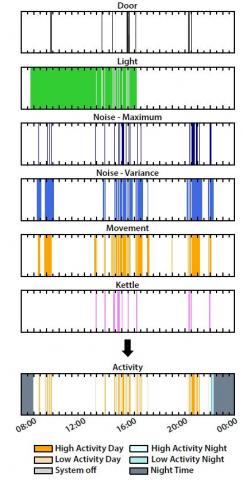A sensor suite to assist older people living independently
With rapidly ageing populations placing increasing pressure on health services in the UK and many other countries, there is increasing demand for assisted living technologies to enable older people to live independently and safely in their own homes for longer.
Often existing technology in this area is proprietary, making it difficult to interface devices from different manufacturers. In addition, some existing systems are no longer supported by their manufacturers. Open technology offers an alternative. Independent developers can contribute to the longevity of the project and the continuous improvement of the devices.
The aim of the project was to develop and test an open-source non-intrusive safety net that can be used to help older people live independently in their own homes for as long as possible while also connecting them with their friends and family.
Results
|
|
|
The students spent 12 weeks to develop a sensor suite incorporating door sensors, power monitors, a fall detector, a general in-house sensor unit and an on-person location-aware communications device.
The sensor suite was build around an ARM mbed microcontroller and a wifi gateway. The sensor suit would collect data unobtrusively and a machine learning algorithm would detect anomalies in an older person's behaviour. E.g. if a person gets up during the night, the door sensors would detect a trip to and from the bathroom. However, if the door sensors would also detect if the person doesn't return to the bedroom and would send an alarm vi text message to a relative or friend.
|
Detecting falls among other activities using machine learning classification. Image credit: Philip Mair |
Data analysis: from raw data to anonymous activity levels. Image credit: Philip Mair |
Impact
The project was published as research article: “Development of an open technology sensor suite for assisted living: a student-led research project”, featured in the themed issue “Sensors in technology and nature” in the Royal Society’s Interface Focus journal.
Two students went on local television to promote the project, generating interest in the technology from care home builders. As a result the students set up their own company Cambridge Assisted Living Technologies (Cambridge ALT) with support from the Sensor CDT.
The team
The interdisciplinary team – comprising engineers, chemists, biochemists, materials scientists and physicists – worked together on the technology and social aspects of the project. Each student contributed with their expertise, e.g. 3D printing, circuit design, programming and system integration, but also acquired new skills, including project and financial management and team leadership.
team – comprising engineers, chemists, biochemists, materials scientists and physicists – worked together on the technology and social aspects of the project. Each student contributed with their expertise, e.g. 3D printing, circuit design, programming and system integration, but also acquired new skills, including project and financial management and team leadership.





